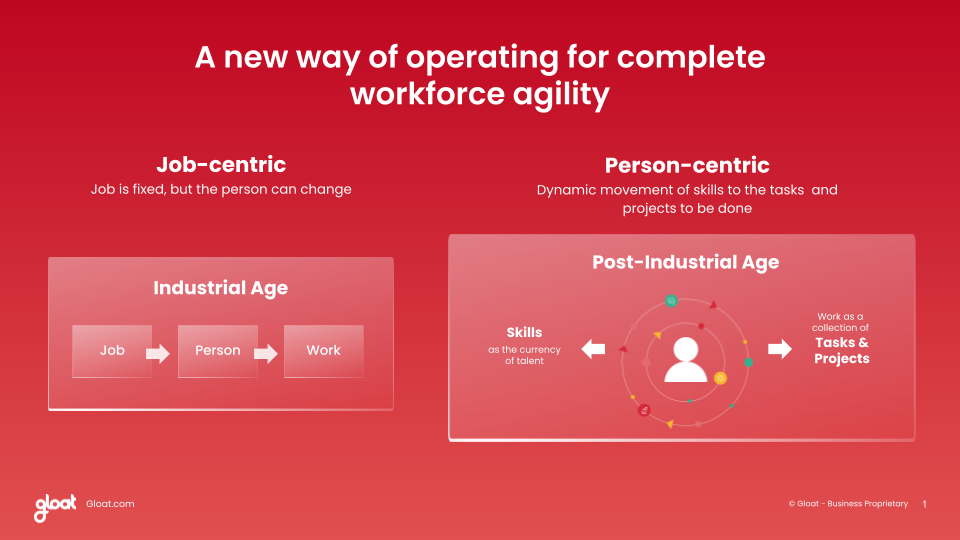Guide to strategic workforce planning
Why workforce agility should be the focus of every organization’s roadmap

As organizations feel the mounting pressures of uncertain markets, evolving business needs, and growing skill gaps, it’s more essential than ever to have a sound roadmap. Historically, companies could feel confident making assumptions about what their workforces would need—change came relatively slow, certainly compared to today, and could be prognosticated and planned out so as not to disrupt operations.
But history is a poor indicator of today’s needs. Strategic workforce planning must evolve to match the speed of today’s reality.
A growing number of organizations are adopting the tenets of skills-based organizations to evolve, breaking down organizational silos in favor of internal talent mobility and empowering employees to achieve their full potential. HR leaders play a key role in setting up a winning strategy for this new organizational principle.
Though 76% of enterprises think talent mobility is important, only 6% believe their organization is “excellent” at enabling mobility according to research from Deloitte. Since modern strategic workforce planning relies on more dynamic ways of working, mobility is a must for unlocking the level of agility that the future of work requires.
What is strategic workforce planning?
Strategic workforce planning is a systematic and continual process of identifying skill gaps in the workforce and developing a methodical plan to ensure the organization has the employees, skills, and knowledge needed to meet current and future business needs.
By pinpointing knowledge gaps, companies can plan effectively to ensure their organization has properly skilled employees in the correct roles, which helps support the business in maintaining efficient operations and achieving its goals. With an impactful workforce planning strategy, a business will always be staffed with the necessary talent, knowledge, and experience to produce positive outcomes.
Why is workforce planning essential for long-term success?
With nearly two-thirds of employers noting that skills gaps are one of their biggest transformation barriers, it’s evident that many leaders are struggling to develop the capabilities their workforces need to thrive.
When companies engage in strategic workforce planning efforts, executives can identify the skills their people need both now and in the future and begin crafting learning pathways to put a stop to knowledge gaps once and for all. Since many leaders view transformation as a business imperative, the sooner they can remove any barriers hindering their change journeys, the sooner their workforce will be able to evolve to keep pace with our ever-changing working world.
What are the 6 stages of strategic workforce planning?
Workforce planning is a complex process that involves analyzing, forecasting, and planning workforce supply and demand to ensure organizations have the right skills in the right places at the right time. The workforce planning process can be broken down into the following phases:
#1. Strategic alignment
During the first stage of workforce planning, leaders from across your organization will come together to align on goals and future objectives that will guide your decision-making process. Stakeholders must agree on the general direction their organization is heading in and begin to consider the types of skills that will be needed to make these goals happen.
#2. Workforce analysis
Next, leaders must assess the skills their people have, as well as their current headcount. With help from skills intelligence systems, executives can also begin forecasting how skill needs are likely to change over time.
#3. Demand analysis
After taking stock of their workforce, leaders must turn their attention towards the skills their organization will need to accomplish their strategic objectives. Executives should consider how consumer expectations are evolving, the rise of AI, and any other factors that are likely to shape the direction of their business.
#4. Gap analysis
After analyzing the supply and demand of workforce skills, leaders must pinpoint any gaps that exist between the two and begin to brainstorm strategies to overcome these potential knowledge shortages.
#5. Creating an action plan
Once executives have a clear understanding of their workforce skills and any impending knowledge gaps, they must devise strategies to overcome these shortages. That could include hiring externally to bring skills into the business that the organization currently lacks, as well as reskilling and redeploying talent into high-priority areas of the business.
#6. Implementation and monitoring
The final stage of strategic workforce planning occurs when leaders align on a strategy to source the skills they need and introduce these plans to their organization. These initiatives may include skill-building opportunities for current employees, posting job descriptions for new roles that will need to be filled, and launching a mentoring program so employees can hone new expertise.
The benefits of emphasizing agility in strategic workforce planning
As AI advances and talent scarcity grows more severe, businesses recognize that forecasting their skill needs and workforce demands will be crucial to stay one step ahead of the accelerating pace of change. Strategic workforce planning offers five key advantages, including:
Minimize hiring costs
When businesses participate in workforce planning, leaders walk away with clear insights about the skills they will need to hire for and those that can be built internally. As a result, companies can reduce talent acquisition expenses by ensuring they are only turning to external hiring when it’s a business necessity.
Identify talent gaps
All too often, leaders aren’t aware of skill gaps until they’ve taken a toll on operating models and business practices. In contrast, companies that participate in strategic workforce planning can identify potential talent shortages before they snowball into bigger problems.
Enable informed talent investment
Strategic workforce planning enables leaders to make informed decisions about the capabilities their workforce will need in the future and how to best acquire them. By harnessing skills intelligence systems, executives can gain insight into the capabilities that are likely to become increasingly important in the new world of work so they can invest in them strategically.
Align HR with business strategy
The first step of workforce planning is ensuring that leaders are aligned on their organization’s goals. By ensuring all stakeholders are on the same page about future skill needs, HR can feel confident that their initiatives will work in tandem with their company’s overarching strategy.
Anticipate and respond to change effectively
From the shift to remote working to the rapid proliferation of generative AI, the past five years have underscored just how quickly events and innovations can cause business models to shift. Strategic workforce planning enables leaders to prepare for the next wave of disruptions by ensuring they have the skills and headcount needed to overcome them.
3 steps to optimize your strategic workforce planning
To make sure strategic workforce planning aligns with your company’s needs, here are three steps to ensure you’re on the right path:
#1. Take stock of workforce skills
Good output requires good input. Surveys show that few organizations believe they’re adept at understanding the gap between their organization’s future workforce requirements and current workforce skills, with only 18% saying they were either “very highly effective” or highly effective” at doing so.
Strategic workforce planning relies on leadership understanding the current capabilities of their workforce. With skills intelligence systems like Gloat’s Skills Foundation, leaders gain a comprehensive picture of the capabilities their people have, any potential knowledge gaps, and the competencies that will become increasingly important in the new world of work.
#2. Anticipate your industry’s needs
Speed and flexibility are at the center of successful workforce planning. As industries align to evolving paradigms—like growing consumer demand for electric vehicles in the automotive space and automation in practically every industry—having the skills to enable new initiatives can help an enterprise stay competitive.
Companies don’t operate in a vacuum, and neither does talent. Skills intelligence systems reveal how an organization’s workforce stacks up against the competition through real-time benchmarking, helping leaders identify the skills that should be developed internally and the additional resources needed to pivot ahead of the curve.
#3. Empower employees to expand their skill sets
Once leaders have a clear picture of their workforce’s skills, it’s up to them to carve new learning and development pathways to help their people hone in-demand skills. Many visionary executives are turning to talent marketplaces to help employees find projects, gigs, full-time roles, and mentoring opportunities that align with the skills they’re looking to build.
Strategic workforce planning in action case study
While many companies are just beginning their workforce planning journeys, there are a handful that have harnessed AI to ensure they have the right skills in the right places at the right time—and Novartis is one of them. The leading pharmaceutical company uses an agile workforce operating system to take stock of workforce skills and develop upskilling and reskilling pathways for their employees.
How Novartis created a unified job architecture
In a market that changes as rapidly as the pharmaceutical industry, Novartis needed to understand fast-emerging trends like omnichannel customer engagement and digitization tools. To level up their workforce planning strategy and gain insight into the emerging learning and development priorities that would prove most crucial, Novartis harnessed Gloat’s Skills Foundation to harmonize data across disparate systems, in turn enabling the organization to create a unified job architecture.
In describing how Gloat’s Skills Foundation equips leaders with complete visibility into workforce capabilities and skill needs, Rene Gessenich, former Head of Strategic Workforce Planning says, “We can get the top skills against any job in our job architecture and have that updated. Then, we do workforce planning where we go into much more detail and see what the roles are, how they’re changing, and what roles we need.” By taking a skills-based approach to strategic workforce planning, Novartis can ensure its people are building the capabilities needed to adapt to a market that is quickly evolving and leaders can gain in-depth insight into the skills employees possess and how these competencies relate to their colleagues’ expertise.
How can companies adapt to changing workforce needs?
Since the pace of change shows no signs of slowing down, it’s up to leaders to upgrade their internal processes and operating models to ensure their companies are pivoting ahead of the curve. By harnessing AI-powered skills intelligence systems like Gloat’s Skills Foundation, executives can keep a pulse on which skills are on the rise and on the decline and assess their workforces’ capabilities to ensure they are upskilling and reskilling accordingly.
If you’re looking to learn more about Novartis’s innovative approach to strategic workforce planning, check out this conversation with their Global Head of Talent Markus Graf and The Josh Bersin Company.




